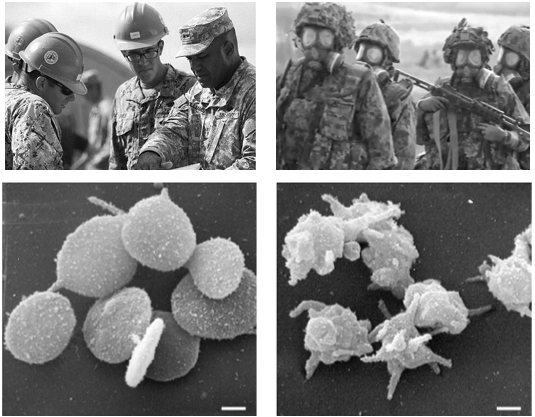The truth about "bad" platelets.
by Elisabeth Maurer-Spurej | Jan 15, 2020
Maybe you think of platelets as the "bad guys" that cause strokes and heart attacks. Or maybe you know someone who's platelets started to "misbehave" so that the body's immune system turned against them. Maybe the diagnosis is immune thrombocytopenia (ITP)?
Do people have "bad" platelets when they suffer from life-threatening conditions that involve their platelets?
In the past I gave talks about platelet microparticles—one of the manifestations of platelet activation.1 I introduced the concept that more platelet fragmentation leads to more microparticles, and therefore many microparticles are a sign of many activated platelets. I also spoke about dynamic light scattering (DLS) which works like street radar, except, instead of measuring the speed of cars, DLS can measure the speed of tiny particles moving in a liquid. In a blood sample these could be platelets and their small fragments, the microparticles, often also called extracellular vesicles or microvesicles.2
Because microparticles are so much smaller than platelets they move much faster—you can see this in the movie to the right. Based on the number of detected microparticles in a sample, dynamic light scattering can tell how activated the platelets in that sample are.3
You saw on the home page that fragmentation into microparticles is part of platelet activation.4
In the published literature you can find thousands of papers talking about disease conditions with elevated microparticles in a patient's blood:
• Diabetes
• Cardiovascular diseases (CVD)
• Depression
• Digestive disorders such as irritable bowl syndrome, Crohn's, and Ciliac disease
• Autoimmune diseases like Rheumatoid Arthritis, Asthma, Allergies
• Various types of low platelet count known as thrombocytopenia
• Infection
• Inflammation
• Cancers leading to tumor-educated, activated platelets
It is not surprising that activated platelets are considered "bad platelets" when they themselves and their microparticle fragments are associated with such a variety of diseases!5
In fact, millions of people take antiplatelet medication like Aspirin® or Plavix® to prevent platelet activation.6 Maybe an analogy could help make sense of the situation.
The large objects of various shapes and sizes are platelets. Notice how your judgement of their shapes changes when you go to full screen and see their different orientations by running the movie. Would you judge them to be more resting on a low-zoom still image?
The tiny round objects that flit in and out of focus are microparticles. Did you notice that they are almost invisible unless you zoom in to full screen?
Let's see if this analogy makes sense when we look at an example: immune thrombocytopenia (ITP). When the immune system removes platelets faster than the bone marrow can produce them the platelet count drops which can lead to easy bleeding and excessive bruising. Interestingly, the Mayo Clinic website states that "the immune system mistakenly removes and destroys platelets" but also recognizes that the triggers are bacterial or viral infections.7
Platelet activation is an integral part of platelet function to protect the entire organism. Just like hazmat soldiers, they sometimes protect the boarder (wound), sometimes deal with hazardous material (pathogens), and sometimes they do both.
"The loss of defenders" (thrombocytopenia) is unfortunate, even seems cruel, but it is a calculated risk for the greater good with countless examples in nature.
Why would removing platelets that interacted with or engulfed pathogens be a mistake?
Continuing the hazmat soldier analogy, depending on how much cleanup is required one might expect to "keep losing defenders" until the problem is solved. In other words, one would not expect to see stable platelet counts for some time. However, in exchange, the underlying problem should get steadily resolved.
The bottom line is that platelet activation is necessary to protect the body. Even the reversible activation in response to low temperature that was discussed in the previous blog is a form of protection. If medical treatment prevents or interferes with platelet activation, it might put the whole body at risk. The good news is that in a healthy system attacks from the outside are usually short. After the hazards are removed the hazmat soldiers can get out of their gear and back to a normal life. Only high intensity or chronic attacks are problematic, especially when they happen to an already stressed or weakened system.
Platelets (like hazmat soldiers) need to rest and exercise to be fit when needed. Our first line defenders are resting when we live healthy lives including exercise, hot/cold exposures and a personalized diet, not without stress but with ample time for recovery.
Platelets activate in response to threats. Platelets need tools—like fibrinogen—and communication—like microparticles—to do their job of protecting and defending us.
There are no bad platelets!
What happens when platelets are activated in a person who wants to donate platelets for transfusion?
Platelets—the hazmat soldiers of the body.
Do you think this is an extreme analogy?
Resting Activated

| Resting |
Activated |
| High capacity for activation. |
Low capacity for additional activation. |
| Lag time before full capacity (preparation required before certain activation status is reached). |
At full capacity "ready to go" (no preparation required before certain activation status is reached). |
| Stimulation needed to "spring into action". |
Additional stimulation could exceed capacity or be lethal. |
More about platelet activation status and transfusions in a future blog—stay tuned!
